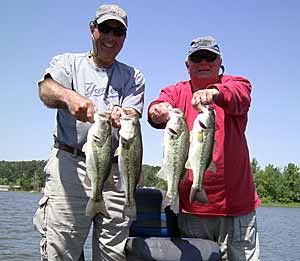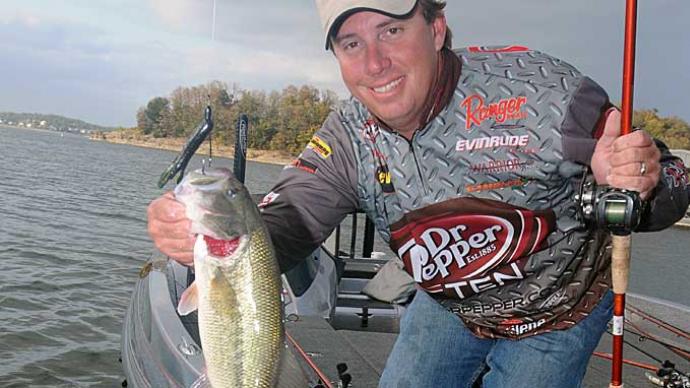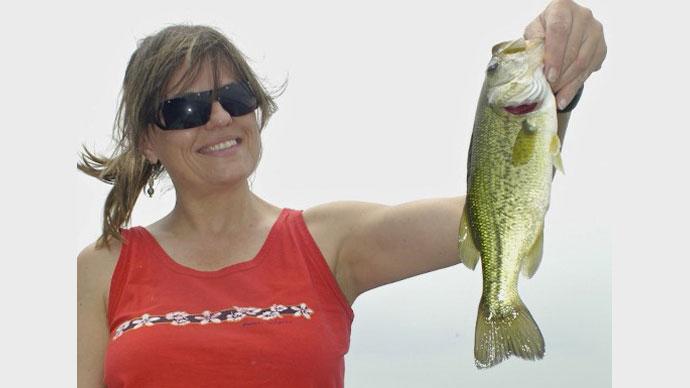
Big Woods Spring Lake is a tea- colored 90-acre blue-collar club lake nestled in the piney woods of East Texas, near the small town of Winnsboro, not far from world-famous giant bass manufacturer, Lake Fork.
In the fall of 1998, club members were concerned with the numbers of fish they were catching. Bass populations seemed low, and the fish just didn't seem to be fat. And, they said fishing had been slow for a couple of years.
This scenario ran counter to what we usually see. Typically, fish are somewhat underweight when the populations are high. An electrofishing survey and water quality analysis told the tale.
Yes, bass numbers were low, as were numbers and species of baitfish. Water chemistry showed low pH, just shy of 6.0. Not much native underwater greenery was present for baitfish cover, and for the most part, the lake was a big bowl, with old stumps dotting scattered areas in formerly wooded bottom lands, underwater for a long time. Not the best cover for bass, either.
The club decided to make a few changes. Reproduction of existing fish populations was low, so in order to beef up the lake's ability to grow fish, the club considered liming the lake, fertilizing and feeding. To boost the take's productivity right away, they thought about stocking fish.
With a limited budget, the club's board of directors decided to stock missing species. They stocked redear sunfish, coppernose bluegill and Florida strain largemouth bass. They intended to change the dynamics of a stumbling fishery by improving genetics and diversifying the list of species.
Blessed with fresh water and constant flow past the turn of the century, the fishery changed dramatically ...
Fast forward to 2003.
The most recent survey shows their stocking has worked. Actually, too well. Now, the lake has thousands of bass, mostly in the 9-12-inch size class, and 15-20 percent underweight. Adequate numbers of adult bluegill with thousands of newly hatched fry line the shore, tucked tightly into a diverse aquatic plant community.
Since 1998, the club has practiced "catch and release." It worked, all right. Now the lake has far too many bass, competing for an increased amount of forage fish, compared to 1998.
But, the problem is age-old, the most common affliction pond managers confront - overcrowded bass.
As club officers watched over the latest survey from the confines of an electrofishing boat, they observed the obvious. Dennis Plank and Jim McCoy looked at each other and came to the same conclusion. "We have too many bass."
The last two or three years spawn, along with bass stocked in 1998 have reversed their trends, leading to a simple solution: Harvest bass.
Looking at relative weights and size distribution, we figured out 88 percent of their bass fall into the 9-12 inch category. A few larger bass, up to 16 inches, were collected in the survey. Those largest bass weren't quite as lean.
Smaller bass, less than 9 inches, were thriving, well within the bounds of weight expectations. Smallest bass were eating smallest forage fish, biggest bass were eating other bass. Fishermen have recently caught bass up to 12 pounds. Guess what a 12- pound bass eats? Anything in this lake, especially 9-12 inch bass. So, if big bass feed on intermediate bass, why harvest big bass food?
Answer: Because not enough big bass exist to control bass numbers. If so, we wouldn't find so many intermediates.
Greg Grimes, a young fisheries biologist based in Georgia, sees this problem quite often in his pond work.
"Without a doubt the most common problem I come across when conducting fishery surveys is the lack of bass harvest," he said. "When your goals are quality or trophy bass fishing selective bass harvest must be a key ingredient in your management plan."
Grimes' observations echo throughout the nation. Look at your pond as a garden. You planted it, nurtured, fed, fertilized. The time comes to harvest, too. Your goals, and the lake, will tell you what to harvest, and when.
As the fishery matures, study your predator fish. Largemouth bass, walleye, trout, even smallmouth bass, tend to take charge and overeat the food chain.
When it comes to raising a few giant gamefish, Grimes has another point.
"If you desire a trophy bass pond I will suggest what Ray Scott told me a few years ago. 'Tell your pond owners to take out all they think they need to and then double it."' Grimes said.
Bear in mind, this recommendation comes from a man who has owned ponds for 25-plus years and popularized the 'catch and release' movement.
But as Grimes pointed out, "Ray Scott will be the first to tell you that philosophy does not apply to private ponds."
That's not to say catch and release isn't an important tool in the pond manager's tool kit. It is, especially in a newly stocked lake or pond. Or, a trophy bass lake, managed correctly.
Selective harvest may be a foreign language to long time fishermen, but it is absolutely one of the most important concepts to embrace, if you want your fishery to survive, and thrive long-term. Here's what happens.
Bass spawn easily in most pond environments. Baby bass rise from the nest, move into the real world, and usually become part of the food chain. But, when 30-50 of those babies survive in an acre of water each year, it doesn't take but a couple of years for intermediate bass to start overcrowding. Theoretically, bass should control their own numbers, with enough adults preying on an overabundance of off- spring. And, a pond stocked properly in the beginning works that way. For about three or four years.
By the time a fishery reaches 4-5 years of age, don't be surprised to see bigger numbers of intermediate bass. Don't be alarmed. Just be cognizant. If your catch rate goes up, and fish weights go down, prepare to switch from catch and release to selective harvest, better known as a "slot limit."
Grimes encourages his clients to remove a few fish occasionally.
"Unless bass are being taken out, the 'new' bass must compete with existing bass for a given food source," he said. "Most pond owners have done a good job of fertilizing, diversifying diet by stocking threadfin shad, and providing a supplemental feeding pro- gram for their bluegill population. While this is critical to providing more groceries for the bass there is only so much to go around. To maximize bass growth, harvest must be performed."
How many bass do you take? For how long?
One landowner in the Southeast we have heard about has an aggressive harvest program of removing all bass under 4 pounds. This approach requires him to remove 200 bass a year and results in low densities of bass. But fishless days also mean there will be times when he catches five bass over 10 pounds in a single day. To date, his best is a 15-pound, 13-ounce monster. His goal is to break his state record, and who's to say he won't do it.
The goals for your own pond may be a bit more modest. If so, that should be reflected in your slot limit.
This pondowner in Dixie is pushing his fishery by actively harvesting small bass. But unless he monitors his fishery closely, it could backfire on him.
Over-harvesting small bass can critically reduce recruitment. In other words, when you take out a 4-pound bass, it never has the chance to make double digits.
What happens when the largest bass reach their potential? That's as big as they get. Without a few players coming up in the minors, he is sure to have a losing season somewhere around the corner. And, with few 10-14 inch bass making their way, giant bass' food chains can be severely overharvested.
The fish will tell you when you have taken enough. Here's some common sense ideas to monitor your gamefish:
Weigh and measure your predators. Find a table of relative weights, and compare your fish. For largemouth, a 10-inch bass should weigh 10 ounces. A 12-incher weighs 12 ounces. A 14- inch bass should weigh 1 pound, 7 ounces. A 16-incher weighs 2.25 pounds, and 18-incher 3.25 pounds.
Plot these numbers on an X-Y graph, using weights as one leg and lengths as the other. Then, compare your fish. Look at relative weights and length size distribution. When bunches of fish clog a specific size range, and those fish are underweight, it's time to change. Invite those fish to dinner.
As you harvest enough, guess what happens? Bass numbers will drop, size ranges will diversify and weights will increase. Keep accurate catch records and your data will tell you when to change tools.
If a balanced fishery is your goal, shoot for varying sizes of bass caught, with relative weights within a goal of 15 percent of "average."
If you like catching lots of bass, keep leaning toward overcrowded bass. But, harvest enough to keep the whole population growing.
Grimes, like most conscientious biologists, believes in catch records.
"The use of a log book is great for recording not only fishing success, but for keeping track of harvest," he said. "The log book should list specific size classes and total numbers of bass to be removed. Accurately figure out the average weight of the size class being harvested. You can use that to post in the log book the total number of bass."
What did Big Wood Springs Lake members decide?
They chose to implement a slot limit, which means only those fish within a certain size range are kept. All others are protected from harvest.
In addition, the club is keeping records of fish removed, and informing their biologist of their total harvest. It's a program well within their budget.
Besides, it's smart fisheries management.
Reprinted with permission from Pond Boss Magazine



